EDWARD V. WILLIAMS
A BYZANTINE ARS NOVA: THE 14TH-CENTURY REFORMS OF JOHN KOUKOUZELES IN THE CHANTING OF GREAT VESPERS
One of the salient manifestations of Byzantine civilization was the continuing ability of the Empire to recuperate its strength throughout a millennium of military, theological, and dynastic crises. After the Latin occupation of Constantinople during the first half of the 13th century, Byzantium once again channeled its creative forces for what was to be the final glow of its intellectual and artistic life. During the Palaeologan dynasty, which ruled the moribund Byzantine state from 1261 until its fall in 1453, a host of outstanding men emerged— mystics, theologians, philosophers, mathematicians, historians, statesmen, artists and their patrons, and composers of monophonie chants for the offices and liturgies of the Byzantine rite. [1]
The most important name associated with Byzantine chant in the 14th century is Ioannes (John) Koukouzeles, traditionally called 'a second John of Damascus', 'the second source of Greek music', or simply 'the master'. Notwithstanding Koukouzeles' preeminence as a composer of Greek Church music, his βίος or vita [2] offers substantial evidence that his
1. Unlike the medieval church music of Western Europe which was to develop along polyphonic lines, the music of the Byzantine rite remained exclusively monophonic, chants of a single vocal line. The neumatic notational system of Byzantine music, which differs radically from the modern Western staff of lines and spaces, was a means of expressing relative pitch and rhythmic values through symbols placed above a Greek text. A given neunte or sign indicates the size of the melodic interval in pitch from the neume which immediately precedes. For a discussion of the Byzantine system of notation, cf. H. J. W. Tillyard, Handbook of the Middle Byzantine Notation, "Monumenta Musicae Byzantinae", Subsidia, I, fasc. i (Copenhagen, 1935) and Egon Wellesz, A History of Byzantine Music and Hymnography, 2nd edition (Oxford, 1961), pp. 261-310. The musical examples which accompany the present study are transcriptions from the Byzantine system into Western notation.
2. Eight manuscripts are known which preserve the vita of John Koukouzeles, who became a saint in the Greek Church and whose feast is celebrated on October 1. An edited collation of two 17th-century sources from the Great Laura on Mount Athos (Laura I. 23 and I. 45) has been published by Sophronios Eustratiades in his article, "Ιωάννης ὁ Κουκουζέλης, ὁ Μαΐστωρ, καί ὁ χρόνος τῆς ἀκμῆς αὐτοῦ", Ἐπετρηρὶς Ἑταιρείας Βυζαντινῶν Σπουδῶν, XIV (1938), pp. 4-9. A Russian translation of the vita in Leningrad 239 (Porfiry Uspensky collection no. 5) by P. A. Syrku appears in his article, "Zhitie Ioanna Kukuzelia͡, kak' istochnik' dlia͡ bolgarskol istorii", Zhurnal’ Ministerstva Narodnago Prosvieshcheniia, CCLXXXII (1892), pp. 132-134. Two important printed versions of the vita can be found in Agapios of Crete's Ἁμαρτωλῶν σωτηρία (Venice, 1851), pp. 292-294 and in Stephanos Lampadarios’ Κρηπὶς, ἤτοι νέα στοιχειώδης διδασκαλία τοῦ θεωρητικοῦ καὶ πρακτικοῦ τῆς ἐκκλησιαστικῆς μουσικῆς (Constantinople, 1890), pp. 125-128.
![]()
212
ethnic background may have been at least half Slavic. [3] From the information provided in his hagiographical biography four conclusions can be drawn about the Balkan background of Koukouzeles : 1) He was born in Dyrrachium, some of whose citizens were Slavs; [4] 2) his native tongue was not Greek; [5] 3) his father may or may not have been Slavic; [6] 4) his
3. Two major problems in the vita of Koukouzeles are his precise epoch and his ethnic origins. The dates of Koukouzeles' activity, object of much scholarly controversy, have been stretched across four centuries — from the beginning of the 12th century to the beginning of the 16th. Cf. Miloš Velimirović, "Two Composers of Byzantine Music: John Vatatzes and John Laskaris", Aspects of Medieval and Renaissance Music; a Birthday Offering to Gustave Reese (New York, 1966), p. 818, n. 1, and Kenneth Levy, "A Hymn for Thursday in Holy Week", Journal of the American Musicological Society, XVI (1963), p. 156, n. 47. The latest evidence and research now shows Koukouzeles to have been active in the first half of the 14th century. Velimirović has already pointed to certain Serbian relationships in the activity of two Byzantine composers of the 15th century: Ioakeim the Monk and Manuel Chrysaphes. See his article, "Ἰωακεὶμ μοναχὸς τοῦ Χαρσιανίτου καὶ δομέστικος Σερβίας", Zbornik radova vizantološkog instituta, VIII2 (Mélanges G. Ostrogorsky II; Belgrade, 1964), pp. 451-454.
4. Dyrrachium, the present city of Durrës on the Albanian littoral, was an Illyrian seaport which lay at a point where the Byzantine, Slavic, and Latin worlds converged. According to Šufflay, all Balkan types were to be found there: Greek, Rumanian-Bulgarian, Bosnian-Dalmation, and Serbian-Montenegrin. Names in historical sources and registers show that not only Greeks and Slavs, but Italians, Albanians, and even a Jewish colony were living in medieval Dyrrachium. Milan von Šufflay, "Das mittelalterliche Albanien", in Ludwig von Thallóczy, Illyrisch-albanische Forschungen, I (Munich, 1916), p. 284. Cf. also Šufflay's "Die Lage und Vergangenheit der Stadt Durazzo in Albanien", in Thallóczy, op. cit., I, p. 162.
5. That Koukouzeles’ native tongue was not Greek the vita indirectly divulges through an episode which relates the traditional origin of his name. The hagiographer discloses that Koukouzeles, when asked by his schoolmates in Constantinople what he had eaten that day, was not yet "in full command of the Greek language" and replied, "κουκία καὶ ζέλια" ('beans and cabbage' in Bulgarian). From this response his schoolmates are alleged to have fashioned the nickname "Koukouzeles". Eustratiades, op. cit., p. 4. Cf. R. Palikarova Verdeil, La Musique byzantine chez les Bulgares et les Russes (du IXe au XIVe siècle), "Monumenta Musicae Byzantinae", Subsidia, III (Copenhagen, 1953), p. 196.
6. Of his father, who died when Koukouzeles was very young according to the vita, nothing further is recorded: Eustratiades, op. cit., p. 4. A few musical sources transmit the composer's surname as "Papadopoulos" which may indicate that Koukouzeles' father was Greek, or that the Slavic name Popović at some point may have been Hellenized, or even that Koukouzeles may have been the son of a priest.
![]()
213
mother was almost certainly Slavic and in all probability Bulgarian. [7] During Koukouzeles' education in Constantinople as a protegé of the emperor, however, he must have been completely Hellenized for, when he abandoned the imperial capital for a monk's life on Mount Athos, he went not to the Bulgarian foundation of Zographou nor to the Serbian monastery of Chilandari but to the Great Laura of Saint Athanasios, the most venerable Greek establishment on the peninsula.
By the beginning of the 14th century a new type of music manuscript was being used in the services of the Greek Church. Officially called Akolouthiai (Ἀκολουθίαι), this book was an anthology and contained within a single volume a collection of chants, both ordinary and proper, for the orders of the morning and evening offices as well as musical settings for the three liturgies. [8] Although similar in general contents, the repertory of each Akolouthiai may reflect the preferences of a particular monastic establishment or even the tastes of an individual scribe. A scribe would copy the traditional repertory without any major alterations but would exercise his own editorial prerogatives in adding new chants by his contemporaries. In this way the repertories of the Akolouthiai were constantly in the process of being brought up to date. [9] The Akolouthiai were distinguished from other Byzantine music manuscripts by
7. The most striking 'Slavicisms' in the vita are words spoken by Koukouzeles' mother: "μόε δέτε μίλο Ἰωάννη γδέμησε" ('My dear child John, where are you?'). This lament, although transmitted in Greek characters in the vita, is a transliteration of Slavic speech: "Мое дѣте милъ Иване, гдѣ ли ми си?" These are the words which Koukouzeles is reported to have used as the text for his composition, the Polyeleos "Bulgara": Eustratiades, op. cit., p. 5. The Polyeleos "Bulgara" has been studied by Mme. Lada Brashovanova-Stancheva in her article, "Prouchvani ıa͡ vŭrkhu zhivota i deĭnostta na Ioan Kukuzel", in Izvestiia na instituta za muzika, VI (Bulgarska Akademi ıa͡ na Naukite; Sofia, 1959), pp. 30-33.
8. This type of manuscript, thought to have been compiled by or under the direction of John Koukouzeles about the year 1300, is also found under such names as Ἀνθολόγιον, Ἀνοιζαντάριον, Ψαλτικὴ, Παπαδικὴ, or Μουσικόν. The official name however, in the plural, is Ἀκολουθίαι meaning 'Orders of Service'. Cf. Oliver Strunk, "The Antiphons of the Octoechos", Journal of the American Musicological Society, XIII (1960), p. 53. For a discussion of the Asmatikon and Psaltikon, the immediate musical predecessors of the Akolouthiai, cf. Levy, op. cit., pp. 131, 149, and 155.
9. Strunk, op. cit., p. 54. No less than fourteen Akolouthiai survive from the 14th century, and the number from the 15th century is more than twice this number. Of approximately fifty Akolouthiai manuscripts known to have been copied before the year 1500, the greatest number are located in three principal repositories: the National Library of Greece in Athens, the library of Saint Catherine's Monastery on the Sinai peninsula, and the numerous monastic libraries on Mount Athos (especially in the collections of Iviron, Vatopedi, and the Great Laura).
![]()
214
the predominance of those chants which were 'newly-composed' and which carried attributions to a number of Byzantine composers. [10] Although the chanted repertories and their sequence in the Akolouthiai vary somewhat from copy to copy, a representative manuscript will transmit the psalmody for the Prooemiac Psalm for Great Vespers. [11] A study of Koukouzeles' contributions to the psalmody of the Prooemiac Psalm will demonstrate the impact of his art upon Great Vespers. [12]
Stylistically and chronologically musical settings for Psalm 103 fall into two basic categories: 1) a small group of anonymous, 'quasi-traditional' chants, [13] and 2) an ever-expanding corpus of 'newly-composed'
10. Velimirović points out that attributions to specific composers were common in Akolouthiai but were somewhat exceptional in other types of Byzantine music manuscripts. Miloš Velimirović, "Byzantine Composers in MS. Athens 2406", Essays Presented to Egon Wellesz (Oxford, 1966), p. 8.
11. The Prooemiac or 'Introductory' Psalm in the numeration of the Greek Septuagint and the Latin Vulgate is Psalm 103; in the Masoretic and King James Psalters, Psalm 104. Each verse of the Prooemiac Psalm is subdivided into two or more poetic lines. Verse 35, for example, the last verse of the Psalm, contains three lines, each of which carries a letter (viz. 35a, 35b, 35c). From verse 28b through verse 35c, that is, from the second line of verse 28 through the third line of verse 35, selected lines of Psalm 103 receive musical settings. Following verse 35c four previous lines of the Psalm are added to the musical performance: verse 19b and 20a with their striking evening imagery, and verses 24a and 24b which function as a summation of the Psalm's spiritual substance. For a discussion of the performance practice of the Prooemiac Psalm, see the forthcoming study by Miloš Velimirović, "The Prooemiac Psalm of Byzantine Vespers", in Words and Music Dedicated to A. T. Merritt (Cambridge, Mass., to be published).
12. By the beginning of the 14th century a millennium of liturgical conflict and amalgamation in the Orthodox East between the rites of Jerusalem and Constantinople had produced Great Vespers (μεγάλος ἑσπερινός), a 'mixed' form of the evening office. Almost universally observed in the Empire during the reign of the Palaeologoi (1261-1453) Great Vespers embraced both monastic and urban features from the two important spiritual centers of the East. For a discussion of the liturgical processes which crystallized in Great Vespers of the 14th and 15th centuries, cf. Mikhail Skaballanovich, Tolkovyĭ tipikon’, I (Kiev, 1910), pp. 393ff, 492; N. D. Uspenskil, "Pravoslavnaıa͡ Verchernıa͡ (istoriko-liturgicheskiĭ ocherk)", Bogoslovskie trudy, I (Moscow, 1959), pp. 33-39; and Anton Baumstark, "Denkmäler der Entstehungsgeschichte des byzantinischen Ritus", Oriens Christianus, 3rd series, II (1927), pp. 22-27.
When preserved in the Akolouthiai the evening office shows at least two, but more frequently three and four, different chanted texts: 1) the 'Invitatory' exclamations (Δεῦτε προσκυνήσωμεν…); 2) the Prooemiac Psalm (Psalm 103); 3) the First Stasis (Psalms 1, 2, and 3); and 4) kalophonic (i.e. embellished) settings for Psalm 2. The second and third items above are to be found in all Akolouthiai which transmit Great
13. Only four settings for the Prooemiac Psalm bear the 'quasi-traditional' label "παλαιόν" or "ἀρχαῖον" ('old'): verses 28b, 29a, 35c, and 24b. Verse 29a is preserved only in Sinai 1293 and Athens 2406, both mid-15th-century sources. A unique 'quasi-traditional' setting for verse 35c appears in the very oldest source, Sinai 1256, and was never recopied. Because of its atypical construction with a Doxology, Alleluias, and δόζα refrains appended to the conclusion of the Prooemiac Psalm, verse 24b will not be considered in this study with the other three 'quasi-traditional' settings.
![]()
215
melodies, the work of individual Byzantine composers. The transmission of these two stylistic strata of the Prooemiac Psalm in five selected Byzantine music manuscripts copied between 1309—1453 is shown in Table 1, (p. 217).
The earliest sources which transmit chants for the Prooemiac Psalm are not Akolouthiai but two Heirmologia: [14] Sinai 1256 (copied in 1309) and Sinai 1257 (copied in 1332). Sinai 1256, the older of the two manuscripts, carries only three lines of the Psalm in 'quasi-traditional' musical settings: verses 28b, 35c, and 24b. The second Heirmologion, Sinai 1257, although it drops the 'quasi-traditional' setting for verse 35c, still transmits the same archaic settings of 28b and 24b. [15] In addition it carries three new unattributed chants for verses 29b, 31a, and 35a. A comparison of these three chant melodies in Sinai 1257 with the same repertory in Athens 2458 (copied in 1336), the oldest dated Akolouthiai, discloses that the three chants, although they bear no attribution, are by no means anonymous. They are in fact the first, second, and fourth melodies ascribed to John Koukouzeles in Athens 2458. Sinai 1257 is the earliest source to show the juxtaposition — although incognito — of two different musical strata in the repertory of the Prooemiac Psalm. [16]
With the transmission of the first chants of Koukouzeles for verses 29b, 31a, and 35a, Sinai 1257 discloses 'the master' as an innovator, the first composer of the 'newly-composed' repertory for Great Vespers. In Athens 2458 two more melodies by Koukouzeles were added to the repertory of the Prooemiac Psalm for verses 33a and 35c, the first complete transmission of the five chant melodies composed by Koukouzeles for the Prooemiac Psalm. [17] In addition to the five compositions of Koukouzeles, Athens 2458 also preserves one setting by Panaretos and
14. A Heirmologion contains the Heirmoi of the Kanon, a musico-poetic form sung during Orthros, the morning office. The anomalous inclusion of Great Vespers in the two Sinai Heirmologia occurs after the normal corpus of Heirmoi.
15. All Akolouthiai which transmit Great Vespers preserve 'quasi-traditional' settings for verses 28b and 24b, the first and last lines of that portion of Psalm 103 which is chanted with refrains.
16. The first known chant by Koukouzeles for the office of Great Vespers is transmitted, not in the repertory of the Prooemiac Psalm, but as a setting for verse 8c from Psalm 3 in the First Stasis. The rubric which accompanies the chant in Sinai 1256 (1309 A.D.) identifies it as "a new melody composed by John Papadopoulos Koukouzeles". This attribution records the oldest known example of a 'newly-composed' setting of Psalm text for Great Vespers and suggests through the adjective "new" that this composition of Koukouzeles, appearing at the beginning of the century, represents a significant break with the older repertory.
17. The numerical identification of Koukouzeles' chants for the Prooemiac Psalm applies to their sequential order in Athens 2458.
![]()
216
Expansions of Composer Abbreviations
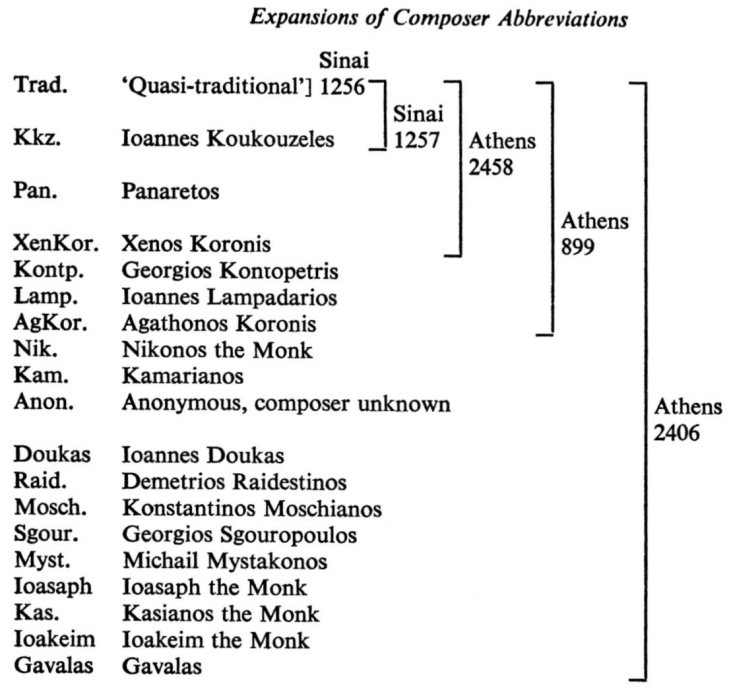
[[ 'Quasi-traditional', Ioannes Koukouzeles, Panaretos, Xenos Koronis, Georgios Kontopetris, Agathonos Koronis, Nikonos the Monk, Kamarianos, Anonymous, composer unknown, Ioannes Doukas, Demetrios Raidestinos, Konstantinos Moschianos, Georgios Sgouropoulos, Michail Mystakonos, Ioasaph the Monk, Kasianos the Monk, Ioakeim the Monk, Gavalas. ]]
three by Xenos Koronis. [18] Each succeeding copy of Akolouthiai shows a marked increase in the number of 'newly-composed' settings between verses 28b and 24b. Athens 2406, copied in 1453, the very year the Empire fell, transmits an extensive repertory for the Prooemiac Psalm.
Both 'quasi-traditional' and 'newly-composed' chants carry a refrain after the line of Psalm text. In its original form the refrain is the short acclamation : δὸζα σοι ὁ θεός ('Glory to Thee, O God'). From a textual standpoint each setting is bipartite: 1) a line from Psalm 103, and 2) the δόζα refrain. See example 1, (p. 226).
The note count in Table 2 reveals that three melodies of Koukouzeles (chants 1, 2, and 4) for the Prooemiac Psalm are substantially longer than the 'quasi-traditional' settings. Of greater internal significance, however, is the ratio of proportion between the length of the music for the Psalm text and the music for the refrain in each type of setting. The refrain in the three 'quasi-traditional' settings occupies roughly one-fifth the entire length of the chant, or, in more obvious terms, the chant of the Psalm text in the older settings is considerably more important than the chants for the refrain.
18. Xenos Koronis was probably a younger contemporary of Koukouzeles also active in the first half of the 14th century. Levy, op. cit., p. 156.
![]()
217
TABLE 1
Transmission of Chants For the Prooemiac Psalm in Five Manuscript Sources
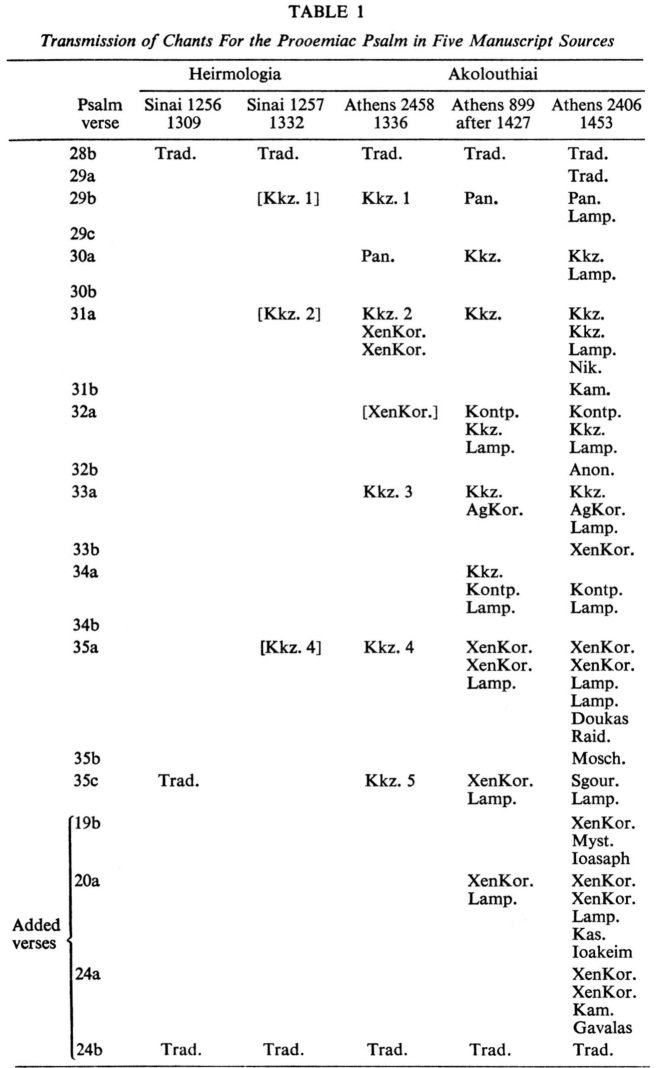
![]()
218
TABLE 2
Proportions of Psalm Texts and Refrains in 'Quasi-traditional' Settings and Chants of Koukouzeles for the Prooemiac Psalm
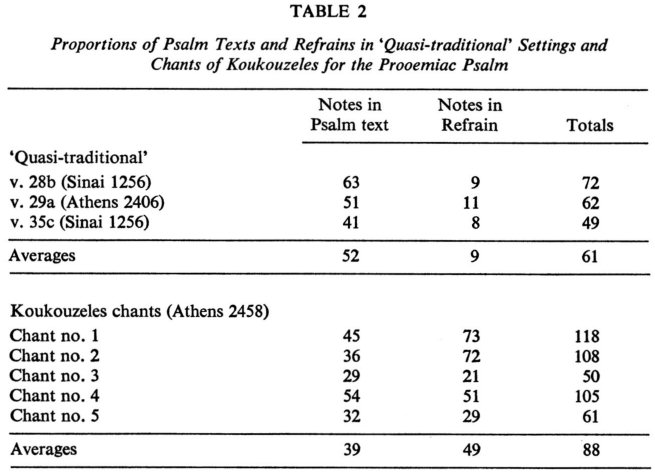
In the chants of Koukouzeles, however, the refrains are never subordinated to the Psalm text either in their musical length or their liturgical import. The refrains in chants 3, 4, and 5 are almost as long as the portion of music which carries the Psalm text; Koukouzeles' chants 1 and 2, on the other hand, reveal that the musical length of the refrain not only greatly exceeds that of the Scriptural text but is roughly twice the length of the Psalm text segment. In striking contrast to the 'quasi-traditional' function of the refrain as a brief cadential appendage to the Psalm text, Koukouzeles has assigned his refrain settings much greater structural significance. He has shifted the emphasis by reversing the older structural relationship and has at the same time increased the overall musical dimensions of his settings.
Table 3 gives overall proportional progressions in the Prooemiac Psalm during the 14th and 15th centuries. The shortest chants are the 'quasi-traditional' settings; at the other end of the scale lie the 'newly-composed' examples of the 15th century. Between the two extremes proportional development moves steadily in the direction of an increase in the size of settings. Table 3 further reveals that this expansion was actually effected within the confines of the refrain alone. The length of the musical segment for the Psalm text remains relatively constant, although the refrain :xpand in the hands of each succeeding generation.
![]()
219
TABLE 3
Averages of Proportions in Psalm Texts and Refrains for 14th and 15th-Century Settings of the Prooemiac Psalm
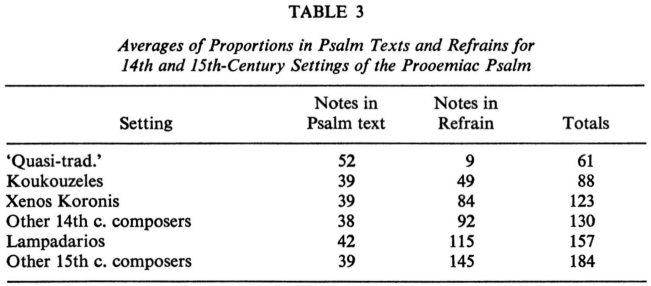
Not only is the text of the refrain itself unembellished in the 'quasi-traditional' chants — simply δόζα σοι ὁ θεός — but the musical settings for this acclamation are almost perfunctory. The refrain functions as no more than a brief formulaic ending to the chanted line of Scripture. The refrains of Koukouzeles' chants 3 and 5, however, may represent this composer's first cautious attempts to expand the text of the refrain and hence to enlarge the musical dimensions of each setting.
|
3. Glory to Thee Glory to Thee. |
5. Glory to Thee Glory to Thee, O God. [19] |
The two texts merely repeat the first two Greeks words (δόζα σοι) of the refrain before and after the acclamation proper. The refrains for Koukouzeles' melodies 1, 2, and 4 reveal even more original and significant innovations by the composer and exhibit the first examples of textual 'troping', a technique which Koukouzeles' successors were to exploit in the 15th century. [20]
|
1. Glory to Thee, Father Glory to Thee, Son Glory to Thee Holy Spirit Glory to Thee |
2. Glory to Thee, Holy [One] Glory to Thee, Lord Glory to Thee, heavenly King Glory to Thee, O God. |
19.
| Athens 2458, f. 12v: |
3. δόζα σοι ὁ θεὸς δόζα σοι. |
| Athens 2458, f. 13r: |
5. δόζα σοι δόζα σοι ὁ θεὸς.
|
20. The most significant feature of the δόζα refrains is their virtual function as a composer’s signature. Each refrain, as troped and set by a given composer, remains attributed to that composer regardless of the source in which it appears. For a discussion of the troped refrains and the principle of melodic migration in the Prooemiac Psalm, see the fothcoming article by Miloš Velimirović, "The Prooemiac Psalm of Byzantine Vespers" in Words and Music Dedicated to A. T. Merritt (Cambridge, Mass., to be published).
![]()
220
4. Glory to Thee, Trinity without beginning
Glory to Thee, O God. [21]
From the elementary repetition and elaboration of certain elements in the original text, the troped refrain attained such proportions in 15th-century settings that it soon overshadowed the Psalm text both in its verbal length and musical emphasis. As a mere cadential appendage to the Psalm text in the 'quasi-traditional' chants the refrain soon grew to dominate the line of Scripture which it accompanied and eventually gave vent to elaborate utterances colored with the subtle nuances of Byzantine theology. [22]
A tabulation of the melodic ranges, in Table 4, for the three 'quasi-traditional' settings reveals in each case that the melodic range of the refrain is substantially smaller than the melodic range of the Psalm text. The range of each refrain, moreover, is confined to the melodic intervals of a fourth or a fifth.
Parallel to Koukouzeles' expansion of the refrain text through troping is his bolder exploitation of vocal range. Not only do the total ranges of the five Koukouzeles settings either equal or exceed the total ranges of
21.
| Athens 2458, f. 11v: |
1. δόζα σοι πάτερ δόζα σοι υἱὲ δόζα σοι τὸ πνεῦμα τὸ ἅγιον δόζα σοι. |
| Athens 2458, f. 12r: |
2. δόζα σοι ἅγιε δόζα σοι κύριε δόζα σοι βασιλεῦ οὐράνιε δόζα σοι δόζα σοι ὁ θεός. |
| Athens 2458, ff. 12v-13r: |
4. δόζα σοι τριὰς ἄναρχε δόζα σοι ὁ θεός. |
22. A refrain trope which echoes the filioque controversy between East and contained in the fifth melody by John Lampadarios:
Athens 899, ff. 44v-45r:
|
δόζα σοι πάτερ ἀγέννητε δόζα σοι υἱὲ γεννητὲ δόζα σοι τὸ πνεῦμα τὸ ἅγιον τὸ ἐκ τοῦ πατρὸς ἐκπορευόμενον καὶ ἐν υἱῷ ἀναπαυόμενον τριὰς ἁγία δόζα σοι δόζα σοι ὁ θεός. |
Glory to Thee, unbegotten Father Glory to Thee, begotten Son Glory to Thee, Holy Spirit which proceed from the Father and reposes in Glory to Thee, Holy Trinity Glory to Thee, O God. |
Another trope by Manuel Koronis, son of Xenos Koronis, alludes to the Hesuchast controversy which split the Empire in the 14th century:
Athens 2401, f. 50r:
|
δόζα σοι κύριε ὁ ϕῶς ἄκτιστον τοῖς μαθηταῖς σου ἐμϕανείσας ἐν τῷ θαβὼρ τριὰς ἁγία δόζα σοι. |
Glory to Thee, Lord, light uncrepearing to Thy disciples on Mount Tabor Glory to Thee, Holy Trinity. |
![]()
221
TABLE 4
Ranges of Psalm text and refrains in 'quasi-traditional' and Koukouzeles settings for the Prooemiac Psalm
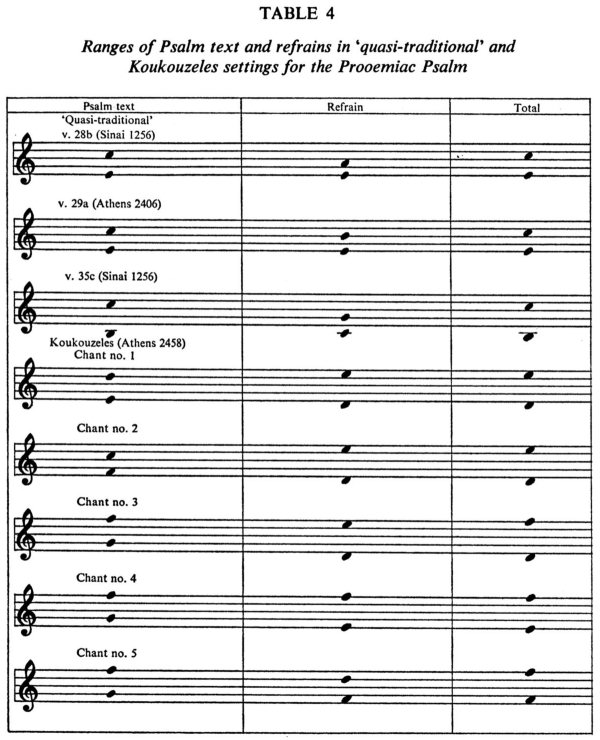
the three 'quasi-traditional' chants, but four out of the five refrains of Koukouzeles are larger in range than the preceding chant which bears the Psalm text. The refrain ranges in the older chants (a fifth) were significantly narrower than the ranges for the Psalm text. Koukouzeles has inverted the relationship of melodic range between the two portions of a setting and has again through his own compositions shifted the ratio of range in the 'quasi-traditional' chants. By mid-14th century Koukouzeles had established the ninth as the preferred melodic interval and the tenth as the maximum vocal spectrum. That later 14th and 15th-century composers demonstrate a preference for even wider ambitus (as shown in Table 5) is no doubt linked to the general increase in the overall length
![]()
222
TABLE 5
Total Ranges of 14th and 15th-century Settings of the Prooemiac Psalm
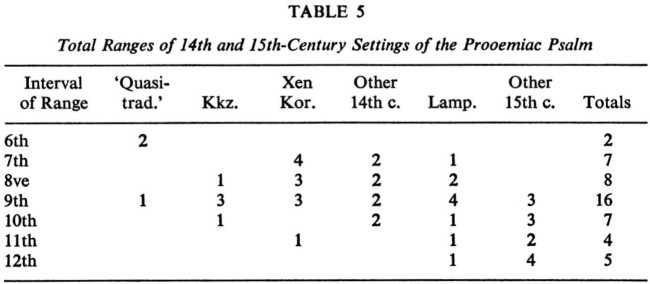
of settings and from the innovations of 'the master'. [23] With the exception of a single chant by Xenos Koronis, not until the advent of John Lampadarios [24] and his 15th-century contemporaries did composers venture beyond Koukouzeles' conception of range.
Although the melodic range of the chant for the Psalm text in the 'quasi-traditional' chants is somewhat greater than the range for the refrain, this relationship was gradually reversed during the 14th and early 15th century until by mid-15th century the size of the melodic range for the refrain was considerably greater than that for the Psalm text. The relationship between the two portions of a chant is illustrated in Table 6. The ambitus of the chant for the Psalm text, like its length, became a frozen component — the conservative element in a setting; the range of the refrain, on the other hand, like the troped expansion of its text, increased untrammeled. Although disjunct melodic motion (i.e. leaps of a third or more) in the predominantly conjunct or stepwise 'quasi-traditional' lines is mainly limited to the interval of the third, the greatest amount of disjunct writing falls in the Psalm text portion of the setting while the melodic line of the refrain remains relatively conjunct. Since the majority of thirds are descending thirds, this feature suggests that the vocal writing is predominantly stepwise in ascent but tends to descend by leaps. The five chants of Koukouzeles for the Prooemiac Psalm, as shown in Table 7, reveal not only a substantial increase over the 'quasi-
23. This phenomenon in range may connote certain virtuosic developments in late Byzantine vocal art. For a study of the kalophonic or 'beautified' repertory for Psalm 2, see my forthcoming article, "The Treatment of Text in the Kalophonic Chanting of Psalm 2", in Studies in Eastern Chant, II (to be published by the Oxford University Press).
24. The work of Ioannes (John) Lampadarios first appears in music manuscripts of the later 14th century. Levy, op. cit., p. 156, n. 47.
![]()
223
TABLE 6
Ranges for Psalm Texts and Refrains of 14th and 15th-Century Settings of the Prooemiac Psalm [*]
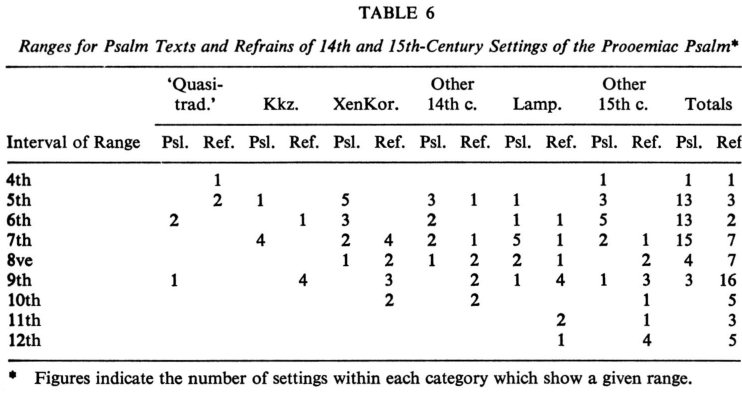
*. Figures indicate the number of setting within each category which show a given range.
TABLE 7
Melodic Intervals of Psalm Texts and Refrains in the Settings of Koukouzeles for the Prooemiac Psalm
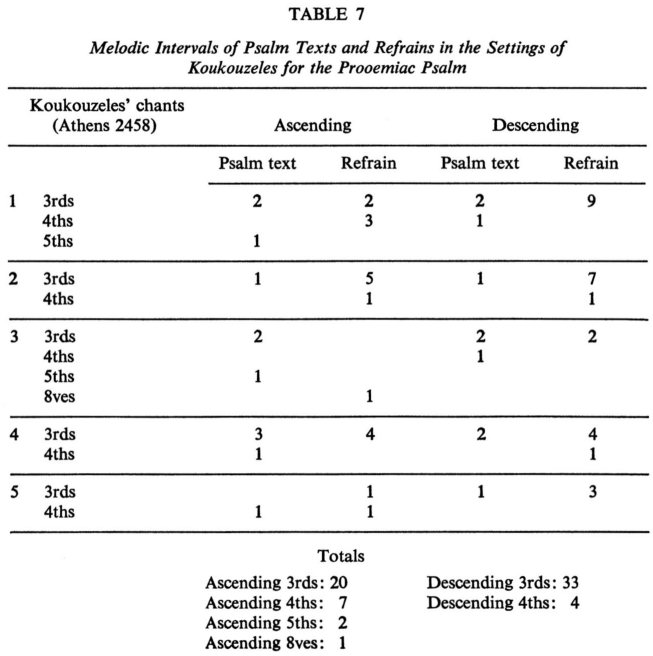
![]()
224
TABLE 8
Melodic Intervals in 14th and 15th-Century Settings of the Prooemiac Psalm

![]()
225
traditional' settings in the disjunct motion of their melodies but also employ a variety of intervals larger than the ascending or descending third. His chants, furthermore, contain unprecedented instances of two and three consecutive leaps and the upward leap of an octave.
Koukouzeles' first, second, and fourth chants which contain the most pronounced textual troping in the refrains also display the most disjunct motion in the melodic line of the refrains. The refrains of chants 3 and 5, on the other hand, with the simplest textual elaboration exhibit the most conjunct lines. From the character of their melodic lines the five Koukouzeles melodies for the Prooemiac Psalm may have been composed in the sequential order 5, 3, 4, 2, and 1. Chants 3 and 5 may represent the composer's stylistic bridge from an older 'quasi-traditional' repertory to the more characteristic 14th-century style revealed in his first, second, and fourth chants.
Table 8 discloses that the frequency of descending thirds, although substantially greater in the 14th century than ascending thirds, is exceeded in the mid-15th century by ascending thirds. This development in the line implies that ascending melodic direction is more conjunct than descending in the 14th century. In the 15th century the opposite is true — ascending motion is more disjunct than descending motion.
The musical structure of the five Koukouzeles chants rests upon three distinctive melodic segments: 1) an initial recitation formula; 2) an inner melodic bridge ; and 3) a cadential formula. See example 2, (p. 226).
The recitation formula is a stereotyped pattern for chanting the opening words of the Psalm text. The basic recitation pitch is G, the finalis of the fourth plagal mode, but accented syllables in the Greek text receive a corresponding musical inflection a whole step higher on A. [25] What at first appears to be a random choice in the number of syllables which carry the recitation formula was actually determined by the syllable count in a given line of the Psalm. The amount of text subjected to formulaic recitation was apparently determined by the length of a given line from the Psalm. Since the last four or five syllables of a line received a more melodic and often more melismatic setting, the portion of the line which preceded, whatever the number of syllables, was relegated to the recitation formula. The longer the line, the more words fell to the
25. Two notable exceptions to this formulaic treatment of the beginning of the Psalm text are the first and second melodies of Koukouzeles whose initia stand closer to a more melodic aspect in the 'quasi-traditional' settings. These chants may reflect the influence of the older tradition upon Koukouzeles' art.
![]()
226
EXAMPLE 1
'Quasi-traditional' setting for Psalm 103, verse 28b (Sinain 1256, ff. 209v-210r)
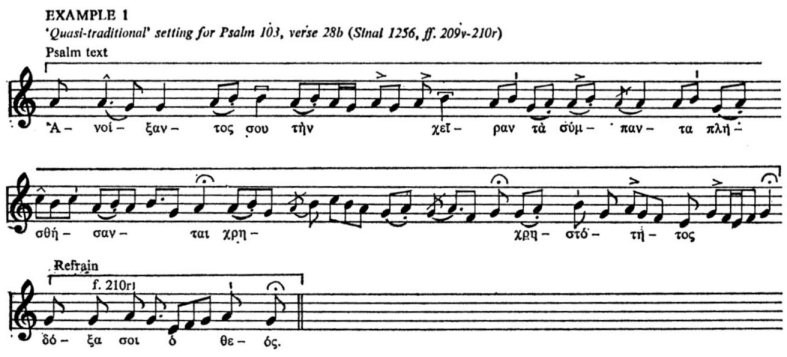
EXAMPLE 2
Koukouzeles Chant no. 5 for Psalm 103, verse 35c (Athens 2458, f. 13r)
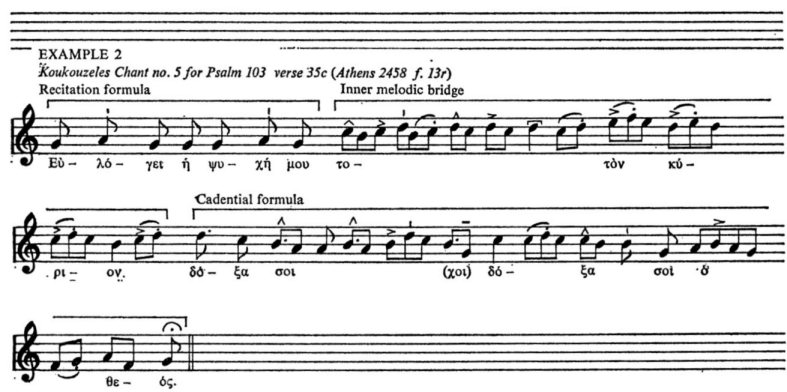
formula; the shorter the line, the less text would be sung to the formula. [26] The inner melodic bridge, supported between two conservative formulae, serves as the outlet for the most individual and original expressions of the Byzantine composer. The pitch of the central segment may rise gradually from that of the recitation formula (e.g. Koukouzeles' chants 1 and 2) or may break abruptly from the level of the note of recitation and immediately commence on a higher tonal stratum (e.g. Koukouzeles' settings 3, 4, and 5). The inner bridge in chant melody 5 sustains the melodic line around D which serves briefly as the center of melodic gravity, a perfect fifth above the finalis of the mode.
26. Some chants are even transmitted in 'truncated' form in which the inner melodic segment alone is copied out in full with new words. The recitation formula is omitted entirely and only the incipit of the refrain is copied. From such an abbreviated version of a setting the singers were obviously expected to fit the initial words of text to the recitation formula. The melody of the Psalm text proper they then sang with new words from the manuscript in hand. The chant for the refrain had previously been copied in full.
![]()
227
The cadential formula returns the melodic line to the finalis of the mode. Comparative examples of a cadential formula in the fourth plagal mode shown in Example 3 reveal the same melodic skeleton as the structural foundation of earlier Byzantine chants as well as for the Koukouzeles settings in the 14th century.
EXAMPLE 3
Formulaic module
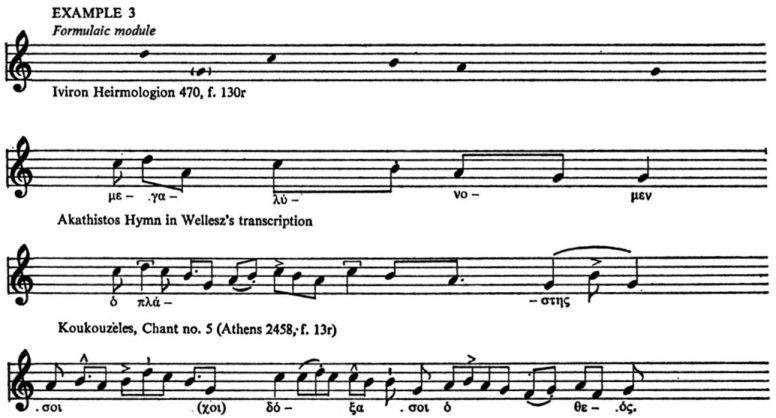
EXAMPLE 4
XenKor. no. 6 (Athens 2622 f. 6v)

Since the cadential formula normally concludes on the same pitch from which the initial recitation pattern began, the melodic structure of each setting may be described as a departure from the finalis, an excursus, and a return to the finalis.
One of the most telling ways through which Koukouzeles reveals his new attitude is in the structure of the 'joint' or textual hiatus between the end of the Psalm verse and the beginning of the refrain. This joint in both the 'quasi-traditional' and Koukouzeles settings is exclusively conjunct (either a unison or a second). Quite unlike the structures of the three 'quasi-traditional' chants which treat the refrain as an addition to the Psalm text, in four of his five settings Koukouzeles regards the refrain as an integral part of the total setting. [27] By avoiding a disjunct interval
27. Chant 3 is the only one of the five by Koukouzeles which shows a cadential ending at the end of the Psalm text.
![]()
228
and a cadential finality on G at the beginning of the refrain, Koukouzeles composes his musical line across the textual rift in a larger melodic arch and demonstrates that his musical concept of a setting is continuous rather than bipartite. Most Byzantine composers after Koukouzeles, however, treat the structure of Psalm text and refrain in the bipartite manner of the 'quasi-traditional' settings and preserve the independence of Psalm verse and refrain.
Aesthetically and musically Koukouzeles' melodies 1 and 2 are his most distinguished works for the Prooemiac Psalm. The more abrupt phrases and common melodic figuration in chants 3,4, and 5 are replaced by vocal passages of imagination and musical sensitivity. Within the formulaic limitations of a conventional musical vocabulary Koukouzeles composed lines with a vocal coloration not to be found in the more restricted ranges and contours of the 'quasi-traditional' settings. Unlike Koukouzeles' restrained use of formulaic devices, Xenos Koronis, his 14th-century contemporary, relies upon chains of stock melodic figures to attenuate his lines.
Whereas Koukouzeles discreetly employs the same formulae with an inner musical logic, Koronis seems to propel his melodies more through determination than through melodic momentum. In the hands of later 14th and 15th-century composers lines often degenerate into unrelieved roulades of melodic clichés. John Lampadarios, even more than Koronis, depends upon successions of formulaic patterns to construct his lines.
EXAMPLE 5
Lamp. no. 3 (Athens 899 f. 43r)
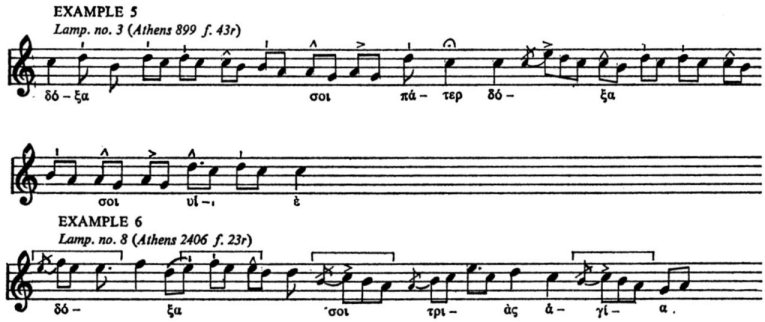
Lampadarios may also extend lines through immediate repetition of short modules joined by melodic 'mortar'.
Such techniques of composition are much more transparent than Koukouzeles' more integrated methods. Only a handful of later settings in the large repertory for the Prooemiac Psalm echo the melodic sophistica-
![]()
229
tion found in the works of 'the master'. Of other 14th and 15th-century settings only three chants by Mystakonos, Doukas, and Raidestinos appear to follow the style of Koukouzeles.
A comparison of the repertories in the earliest sources which transmit chants for the Prooemiac Psalm of Great Vespers reveals that by 1332 this psalmody had entered an epoch of new musical enrichment. The 'newly-composed' settings, however, were established between façades of an older and accepted musical practice, a choice which may represent a reluctance among Byzantine composers to alter appearances. The two 'quasi-traditional' buttresses (verses 28b and 24b) support an immense span of new musical activity between 1332 and 1453. Both the troped text of the refrain and the more vigorous and original inner melodic segment of the chant poise a precarious balance between traditional forces of stability and new impulses toward artistic freedom. In their musical litanies Byzantine composers, like Byzantine artists, cast new ideas in archaic crucibles and shaped each new work in the molds of an ever-valid past.
Statistical calculations for proportion, range, melodic line, and structure thrust a revolutionary light upon the work of John Koukouzeles, the first composer to turn his back upon an archaic, anonymous musical practice and the first to offer a 'new art' for the evening office. As a Byzantine musician Koukouzeles stands preeminent among figures of the Palaeologan renaissance. As the composer who launched an ars nova in the Orthodox East, his innovations in 14th-century Byzantium parallel those of Philippe de Vitry and Guillaume de Machaut, his contemporaries in the West.